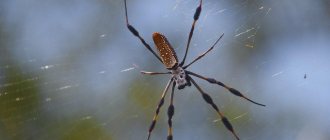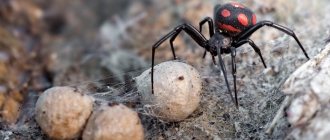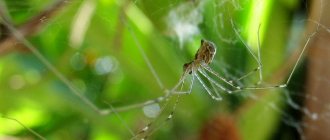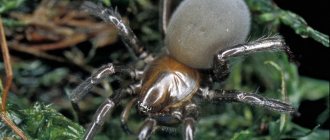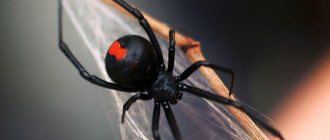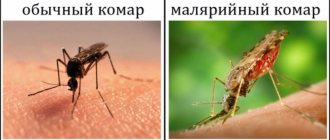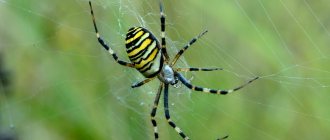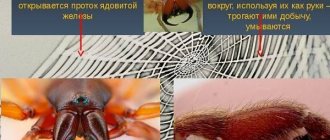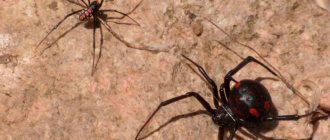- Wild animals
- >>
- Arachnids
One of the most dangerous spiders on our planet is the Brazilian wandering spider , or as it is popularly called “banana” for its love for these fruits and for the fact that it lives on banana palms.
This species is very aggressive and dangerous to humans. The animal's venom is extremely strong, because it contains large doses of the neurotoxin PhTx3. In small quantities, this substance is used in medicine, but in large concentrations of this substance it causes loss of muscle control and cardiac arrest. So it’s better not to meet this species, and when you see it, don’t touch it nearby and hurry away.
Origin of the species and description
Photo: Brazilian wandering spider
Phoneutria fera or the Brazilian wandering spider belongs to the genus Ctenidae (runners). This species was discovered by the famous Bavarian naturalist Maximilian Perti. He devoted many years to studying these spiders. The name of this species is taken from the ancient Greek φονεύτρια; this term means “killer”. This type of spider received its name for its deadly danger.
Video: Brazilian wandering spider
Maximilian Perty combined several species P. rufibarbis and P. fera into one genus. The first species is slightly different from the typical representatives of this genus, and is its dubious representative.
This genus includes several species:
- Phoneutria bahiensis Simó Brescovit, was discovered in 2001. Lives in Brazil and America mainly in forests and parks;
- Phoneutria eickstedtae Martins Bertani discovered in 2007, the habitat of this species is also the warm forests of Brazil;
- Phoneutria nigriventer was discovered back in 1987 and lives in Brazil and Northern Argentina; Phoneutria reidyi lives in Venezuela, Guyana, in the warm forests and parks of Peru;
- Phoneutria pertyi discovered in the same year, lives in the tropical forests of Brazil;
- Phoneutria boliviensis habitat Central and South America;
- P.fera lives mainly in the Amazon, Ecuador, and the forests of Peru;
- P. keyserling is found in southern Brazil.
Like all spiders, it belongs to the type of arthropod arachnids. Family: Ctenidae Genus: Phoneutria.
Good from a killer
But the reputation of a killer did not prevent scientists from finding practical benefits for humanity in him,
especially for his stronger half. The reason is that its venom contains the Th2-6 toxin, which promotes a powerful, albeit extremely painful, erection. Experiments conducted to date have confirmed that the use of this toxin in medicine can provoke the development of a drug that cures erectile dysfunction.
So, perhaps, the Brazilian soldier spider will again get into the Guinness Book of Records, but this time for his contribution to the development of drugs for impotence .
Appearance and features
Photo: Poisonous Brazilian wandering spider
The Brazilian wandering spider is a fairly large arthropod. The length of an adult reaches 16 centimeters. Moreover, the body of the arthropod is about 7 centimeters. The distance from the beginning of the front legs to the end of the hind legs is approximately 17 cm. The color of this type of spider is slightly different, but in most cases it is dark brown. Although there are also spiders of yellowish and red shades. The entire body of the spider is covered with small, dense hairs
The spider's body is divided into a cephalothorax and an abdomen, which is connected by a bridge. It has 8 strong and long legs, which are not only a means of transportation, but also act as instruments of smell and touch. The legs often have black stripes and spots. The legs of this type of spider are quite massive, even somewhat similar to claws. There are as many as 8 eyes on the spider’s head; they provide the spider with a wide view.
Interesting fact: Although the banana spider has so many eyes and can see in all directions, it does not see very well. He reacts more to the movement of objects, distinguishes the silhouettes of objects, but does not see them.
Also, when examining the spider, you can notice pronounced chewing; during an attack they are especially visible. When attacked, the spider demonstrates the lower part of its body, on which bright spots are visible, to scare away enemies.
Tegenaria brownie
This type of spider is widespread throughout Europe and is also called the large house spider. It also inhabits the countries of Central Asia, Africa, as well as Uruguay and Argentina. The length of its body is about 7 and a half centimeters, and together with the limbs - about 15 cm maximum. The body is pale gray in color, and the front legs are brown. Females of this species constantly carry a cocoon with eggs with them until the spiders are born. Tegenaria moves quite quickly. Prefers to live in caves, as well as in abandoned outbuildings. Since this species also chose hot countries for its life activities, it is very difficult to meet it.
10 BIGGEST SPIDERS IN THE WORLD.
Watch this video on YouTube
Where does the Brazilian wandering spider live?
Photo: Dangerous Brazilian wandering spider
The main habitat of this species is America. Moreover, most often these arthropods are found in the tropical forests of Central and South America. Representatives of this species can also be found in Brazil and northern Argentina, Venezuela, Peru and Havana.
Spiders are thermophilic; the main habitat of these arthropods is the tropics and jungle. There they are placed on the crowns of trees. Spiders do not build shelters or burrows for themselves; they constantly move from one habitat to another in search of food.
In Brazil, spiders of this species live everywhere, perhaps only in the northern part of the country. Both in Brazil and in America, spiders can crawl into houses, which terribly scare the local population.
They love warm and humid tropical climates. Spiders of this species do not live in Russia due to the climate. However, they can be found accidentally brought from warm countries in boxes with tropical fruits, or by spider lovers for breeding them in a terrarium.
In recent years, this dangerous animal is increasingly being kept at home as pets. At home, they can live all over the world, but keeping them is not recommended due to the extreme danger of this species. Spiders also don’t live well in captivity, so you need to think carefully before getting such a pet.
Now you know where the Brazilian wandering spider lives. Let's see what he eats.
Tarantulas
Tarantula spiders (Theraphosidae) are a whole family of arachnoids found in Africa, Australia and on the ocean islands in South America. These are the largest spiders (up to 20 cm), which some exotic lovers are fond of and even keep them at home in terrariums.
Tarantulas do not pose a danger to adults, although they can cause muscle pain and fever. However, the poison can be fatal for pets or children.
Their bright, beautiful fur is actually poisonous hairs. The spider combs the hairs from its abdomen and throws it at its prey. If it comes into contact with the skin or eyes, the poison causes pain, itching, and severe vision impairment.
What does the Brazilian wandering spider eat?
Photo: Brazilian wandering spider in America
The diet of this type of spider includes:
- various small insects and their larvae;
- snails;
- crickets;
- small spiders;
- small caterpillars;
- snakes and lizards;
- various fruits and tree fruits.
Also, the spider is not averse to feasting on small birds and their young, small rodents such as mice, rats, and hamsters. The wandering spider is a dangerous predator. He lies in wait for his victim in a hiding place, and does everything so that the victim cannot notice him. When it sees the victim, the spider rises on its hind legs. The forelimbs are raised and the middle limbs are placed to the side. This is how the spider looks the most intimidating. From this position it attacks its prey.
Interesting fact: During the hunt, the wandering spider injects poison and its own saliva into its prey. The effect of the poison completely paralyzes the victim. The poison blocks muscle function, stops breathing and the heart. The spider's saliva turns the victim's insides into a slurry, which is then drunk by the spider.
For small animals, frogs and rodents, death occurs instantly. Snakes and larger animals suffer for about 10-15 minutes. The victim will no longer be able to escape after a spider bite; death in this case is already inevitable. The banana spider goes out hunting at night, and during the day it hides from the sun under leaves on trees, in crevices and under stones. Hides in dark caves.
The banana spider can wrap its dead victim in a cocoon of web, leaving it for later. While hunting, spiders can hide in the leaves of trees in order to be invisible to the prey.
About this article
Contributor(s): wikiHow Staff Editor
This article was produced by our experienced team of editors and researchers, who reviewed it for accuracy and comprehensiveness. wikiHow carefully monitors the work of its editors to ensure that every article meets our high quality standards. This article has had 8,094 views.
Categories: Home Security
English:Identify a Brazilian Wandering Spider
Italiano:Identificare un Ragno Errante Brasiliano
Português:Identificar Uma Aranha Armadeira
Deutsch:Eine Brasilianische Wanderspinne erkennen
Seal
Features of character and lifestyle
Photo: Brazilian wandering spider
Brazilian wandering spiders lead a solitary lifestyle. These spiders have a relatively calm disposition; they attack first only during a hunt. Spiders do not attack large animals and people if they feel safe. Phoneutria do not build houses, do not create shelters and shelters. They constantly move from one place to another. They hunt at night and rest during the day.
Banana spiders are aggressive towards their relatives. Cases of cannibalism occur frequently. Small spiders are eaten by older individuals; the female is able to eat the male after mating with him. Like all predators, they can attack any enemy. Moreover, most often he can defeat even a large victim thanks to his deadly poison.
Spiders of this species are very aggressive. They jealously guard their territory; males can even fight each other for territory and females. In captivity, spiders of this species feel unwell, experience severe stress, and live less than their relatives who live in the wild.
Brazilian wandering spiders run quickly, climb trees, and are constantly on the move. The main occupation of these spiders is to weave webs. And unlike ordinary spiders, this species uses the web not as a trap, but in order to wrap already caught prey in it and lay eggs at the time of mating.
The web is also used to quickly move through trees. This type of spider attacks people only for the purpose of self-defense. But a spider bite is fatal, so if you find a spider, do not touch it and try to take it away from your home.
Behavior in the wild
Banana spiders are predators. Weaving and using webs is a major part of the life of orb weavers.
To catch prey, they weave huge nets (up to one and a half meters in diameter), in which they can catch even small animals - lizards, mice, birds. The arachnids themselves watch over unwary insects nearby, catching the slightest vibrations of the web with their sensitive paws.
The best time for hunting is at night, when the web shines, attracting many insects with reflected light, which become prey, getting stuck and sticking to the nets.
Banana spiders have glands that produce a liquid secretion to produce web threads. The female injects poison into the stuck prey, then wraps it in a net to firmly hold it until the required time.
In limbo, a half-dead victim can hang for several hours until the spider decides to have lunch. Males do not weave webs; they feed on the remains of their prey. After mating, males often die - the female eats them.
The spider that constantly lives in bananas does not eat fruit. He gets enough of the insects that are attracted to the fruits and foliage of banana groves.
Social structure and reproduction
Photo: Poisonous Brazilian wandering spider
As mentioned earlier, Brazilian spiders live alone and meet with a female only for reproduction. The male offers food to the female, appeasing her with it. By the way, this is also necessary so that he is alive and the female does not eat him. If the female has eaten enough, she may not want to feast on the male, and this will save his life.
When the fertilization process ends, the male quickly leaves so that the female does not eat him. Some time after fertilization, the female spider weaves a special cocoon from the web in which she lays eggs; sometimes eggs are also laid on bananas and leaves. But this happens rarely; most often, the female, in caring for the offspring, hides the eggs in the web.
After about 20-25 days, these eggs hatch into baby spiders. After birth, they spread out in different directions. Spiders of this species reproduce very quickly, as several hundred spiders are born in one litter. Adult spiders live for three years, and during their lifetime they can produce quite a large offspring. Neither the mother nor the father takes any part in raising the offspring.
The cubs grow up on their own, feeding on small larvae, worms and caterpillars. Spiderlings can hunt immediately after hatching from the egg. During their growth, spiders undergo molting and loss of exoskeleton several times. During the year, the spider molts from 6 to 10 times. Older individuals shed less. The composition of spider venom also changes as the arthropod grows. In small spiders, the poison is not so dangerous; over time, its composition undergoes changes, and the poison becomes deadly.
Goliath tarantula
Tarantula Goliath
The spider is of impressive size, can reach 170 grams, its height including legs is 30 cm, belongs to the tarantula family. Lives in the tropics of South America. It builds burrows up to half a meter deep with the entrance covered with cobwebs. Females can survive up to 25 years, males - up to 6.
Goliath suddenly sneaks up and quickly pounces on its prey, poisoning it with its poisonous fangs. It feeds on frogs, small snakes, mice and birds.
The Goliath tarantula is capable of producing powerful sounds with its chelicerae, which can be heard even 5 meters away. To defend themselves, they use their bright brown hairs, which irritate the mucous membranes of the mouth and nose, which the spider shakes off its body towards the enemy.
Natural enemies of Brazilian wandering spiders
Photo: Brazilian wandering spider in bananas
Spiders of this species have few natural enemies, but they still exist. This is a wasp called the Tarantula Hawk, it is one of the largest wasps on our planet. This is a very dangerous and scary insect.
Female wasps of this species are capable of stinging a Brazilian spider; the venom completely paralyzes the arthropod. After this, the wasp drags the spider into its hole. The most amazing thing is that the wasp needs the spider not for food, but to care for its offspring. The female wasp lays an egg in the belly of the paralyzed spider, after some time the baby hatches from it and eats the belly of the spider. The spider dies a terrible death from being eaten from the inside.
Interesting fact: Some species of this genus use a so-called “dry bite” in which no poison is injected, and such a bite is relatively safe.
Birds and other animals in their natural environment avoid them, knowing how dangerous these spiders are. Due to their poisonous nature, Brazilian spiders have very few enemies. However, spiders of this kind do not attack on their own; before the fight, they warn their enemy about the attack with their stance, and if the enemy retreats, the spider will not attack him if he feels safe and decides that nothing threatens him.
Spiders often suffer death from other animals during fights with large animals, or during fights with their relatives. Many males die during mating because they are eaten by females.
People are just as dangerous to spiders; they are often hunted for their poison. After all, poison in small quantities is used as a means to restore potency in men. In addition, people are cutting down the forests in which spiders live, so the population of one of the species of this genus is under threat of extinction.
Record-breaking lethality
The Brazilian soldier spider acquired its reputation as the most dangerous spider on the planet, not least thanks to its aggressive behavior. As soon as a situation arises that it identifies as dangerous, the spider takes a special stance on its legs, stretching threateningly upward and pointing its front legs towards the enemy.
The indicative aggressiveness of the Brazilian soldier spider is associated with its focus on active hunting. While pursuing a victim, it can develop a running speed decent for a spider, and is also capable of jumping a considerable distance.
Since the spider loves to enter people's homes in search of a calm, quiet place, its meeting with
in humans - this is a fairly common occurrence. Unfortunately, they often have a tragic outcome. The impact of the venom of the Brazilian wandering spider on children and the elderly is especially dangerous.
The content of a powerful neurotoxin in the poison causes the victim to experience total muscle paralysis, leading to fatal suffocation. A person bitten by this spider feels terrible pain throughout the body and complete numbness. As a rule, the subsequent muscle paralysis causes death. From the time of the bite to death can take from 2 to 6 hours.
If you are bitten by a Brazilian soldier spider, you should immediately seek help from a medical facility. Currently, there is an antidote for the bite of this spider, although it is extremely toxic to the body.
House bees are amazing insects that produce many useful products. Do you want to catch wild bees, but don't know how? Then read this article.
Sand wasps are capable of digging deep holes in the sand. You can find a full description of the insect at this link.
Danger to humans
Spider venom often contains neurotoxins that affect the nervous system of the victim. Less common are insects with a hemolytic component of the venom, which primarily affects the circulatory system and prevents blood clotting in mammals.
An interesting fact is the selective action of the poison. The same spider is capable, for example, of killing a large chicken, but the poison will have minimal effect on a much smaller frog.
Poison with a hemolytic component is used for medical purposes. With its help, blood clots are dissolved in the human circulatory system and heart attacks are prevented.
About 3% of the representatives of the spider order pose a danger to humans, of which several of the most formidable species can be identified, encounters with which are best avoided:
Topping the list is a resident of Brazil – the running spider. The neurotoxin that is part of its poison causes pathological disturbances in the activity of the respiratory center, which leads to human death.
The six-eyed sand spider from Africa takes second place of honor - its venom not only paralyzes the nervous system, but also affects the blood - after a bite, heavy bleeding occurs due to the destruction of the walls of blood vessels. The Sydney Atrax, distinguished by its mournful black body color, is found only in Australia. The death of a person after being bitten by this insect occurs within the next few hours.
The black widow is also a dangerous spider for humans. Its poison affects many organs of the human body, which can lead to death
However, this spider is distinguished by enviable caution - when meeting a person, it would rather take a threatening pose than attack first. A spider with a cute red spot on its abdomen (red-backed) can cause almost instant paralysis. But, despite the mortal danger, this insect is often kept as a pet.
https://youtube.com/watch?v=snUfEI92_MA
